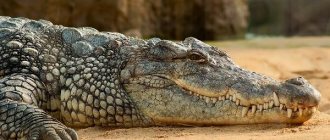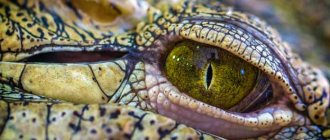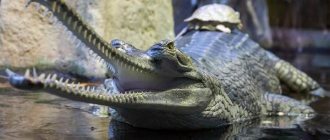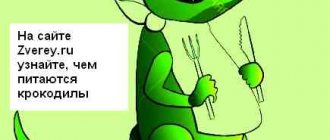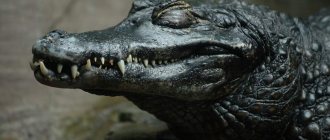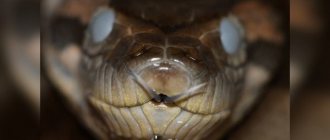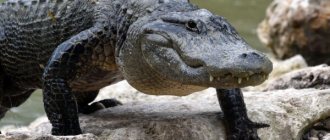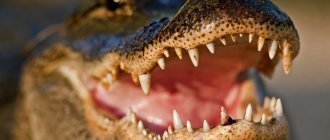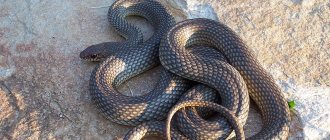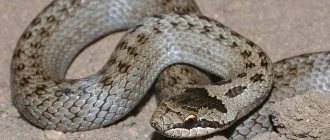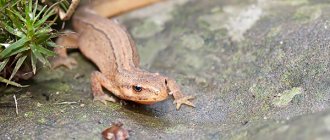- Wild animals
- >>
- Reptiles
The Cayman is the oldest inhabitant on our planet, whose appearance has remained virtually unchanged. The changing habitat and natural enemies of the caiman played a role in the formation of its adaptive characteristics and unique character. The caiman is a representative of the predatory order of Crocodiles, but has fundamental differences due to which it can be easily recognized.
Origin of the species and description
Photo: Cayman
In the origin of caimans, scientists agree that their ancient ancestors are extinct reptiles - pseudosuchians. They lived approximately 230 million years ago and gave rise to dinosaurs and crocodiles. Ancient caimans differed from modern representatives of the genus in having longer legs and a short muzzle. About 65 million years ago, dinosaurs became extinct, and crocodiles, including caimans, were able to adapt and survive in new conditions.
Video: Cayman
The genus of caimans is part of the alligator family, a class of reptiles, but stands out as an independent unit due to the peculiarities of its external structure. During the process of evolution, a bone frame in the form of plates connected by movable joints was formed on the belly of caimans. This protective “armor” protects caimans well from attacks by predatory fish. Another distinctive feature of these reptiles is the absence of a bony septum in the nasal cavity, therefore their skull has a common nostril passage.
Interesting fact: “Caiman, unlike alligators and real crocodiles, do not have lacrimal glands in the structure of their eyes, so they cannot live in highly salty waters.”
The body structure of caimans is adapted to life in aquatic conditions. In order to easily drift through the water and surprise its prey, the caiman's body is flattened in height, its head is flat with an elongated muzzle, short legs and a strong, long tail. The eyes have special membranes that close when submerged under water. On land, these creatures can move quite quickly, and young individuals can even gallop.
Interesting fact: “Camans are capable of making sounds. In adults this sound resembles the barking of a dog, and in baby caiman it resembles the croaking of a frog.”
The caiman genus includes 5 species, two of which (Caiman latirostris and venicilensis) are already extinct.
Currently, 3 types of caimans can be found in nature:
- Crocodile or common caiman, spectacled (has four subspecies);
- Broad-nosed or broad-nosed caiman (no subspecies);
- Paraguayan or piranha caiman, yacar (no subspecies).
History of the discovery of the species
The crocodile caiman was described in 1758 by the Swedish naturalist Carl Linnaeus and assigned the binomial name Caiman crocodilus to the species. Currently, the taxonomy distinguishes from 3 to 5 subspecies of this reptile, which differ in color and skull size.
Crocodile caiman (Caiman crocodilus).
Appearance and features
Photo: Caiman crocodile
Representatives of the three species of caimans are similar to each other, but have individual external differences.
The crocodile caiman is characterized by the following external signs:
- Dimensions - body length of males is 1.8-2 meters, and females - 1.2-1.4 meters;
- Body weight ranges from 7 to 40 kg. The muzzle has an elongated shape with a narrowed anterior end. There are bony growths between the eyes that create the appearance of glasses, hence the name of this species. On the outer part of the eye there is a triangular ridge, inherited from their ancestors;
- There are 72-78 teeth in the mouth, the upper jaw covers the lower teeth. On the lower jaw, the first and fourth teeth are quite large, which is why notches have formed on the upper jaw;
- The color of an adult varies from dark green to brown, while the young are yellow-green with contrasting spots along the body.
Interesting fact: “Crocodile caimans change their body color to black at low temperatures. This ability of his skin is provided by pigment cells - melanophores.”
The broad-faced caiman, compared to other species, has the following characteristics:
- Dimensions - males are up to 2 meters in length, but there are representatives up to 3.5 meters. Females are shorter;
- The caiman's muzzle is wide and large, with bone growths running along it;
- There are no grooves on the upper jaw for the large teeth of the lower jaw, like in a crocodile caiman;
- Body - on the back there are many dense ossified scales, and on the stomach there are several rows of bone plates;
- The color is olive green, but lighter. There are dark spots on the skin of the lower jaw.
The Paraguayan caiman has the following appearance features:
- Dimensions - body length is usually within 2 meters, but among males there are individuals 2.5 - 3 meters;
- The structure of the jaw is like that of a crocodile caiman;
- Body color is brown, varying between light and dark tones. There are dark brown stripes on the body and tail.
Who is bigger, a crocodile or an alligator?
To answer this question, it is necessary to find out what the sizes of the largest and smallest representatives of both groups are.
The largest species of alligator is the Mississippian. The largest individuals of this species had a length of about 4.5 meters, however, there was information about specimens whose length reached 5.8 meters and weighed about 1 ton. However, most experts doubt these reports.
Crocodile hiding in the water
The largest species of the group of true crocodiles is the combed one. Males of this species can reach monstrous sizes - up to 7 meters and weight - up to 2 tons. On average, the length of these animals is 5.2 meters.
The smallest species of the alligator family is the smooth-faced Cuvier caiman, whose maximum length is 210 centimeters, while the average is 150 centimeters.
The smallest species of crocodiles is the blunt-snouted one. Its maximum length is 190 centimeters, the average is 150 centimeters.
Crocodile in the water
Thus, we can say that crocodiles are both the largest and smallest representatives of the group.
Where does the caiman live?
Photo: Caiman animal
The habitat of these reptiles is quite wide and depends on the thermal preferences of the caiman species. The distribution area of the crocodile caiman is tropical and subtropical waters of South and Central America. It is found from Guatemala and Mexico to Peru and Brazil. One of its subspecies (fuscus) was relocated to the territory of certain American states bordering the Caribbean Sea (Cuba, Puerto Rico).
The crocodile caiman prefers bodies of water with stagnant fresh water, near small rivers and lakes, as well as wet lowlands. It can not live long in salt water, no more than two days.
The broad-faced caiman is more resistant to low temperatures, therefore it is found along the Atlantic coastline in the waters of Brazil, Paraguay, Bolivia, and northern Argentina. Its favorite habitat is wetlands and small river inlets with fresh, sometimes slightly salty water. It can also settle in ponds near people’s homes.
The Paraguayan caiman prefers to live in areas with a warm climate. It lives in the south of Brazil and Bolivia, in the north of Argentina, Paraguay in swampy lowlands. It can often be seen among floating plant islands.
Crocodile Caiman (Caiman crocodilus)
Description
One of the most common species of the alligator family, the crocodile caiman has a conservation status of LC (Least Concern) and is included in Appendix II of the CITES Convention.
This means that at the moment there is no obvious threat of extinction of the species, but trade in these reptiles must be strictly regulated by each country in whose territory the species' habitat extends. Unlike other relatives, the crocodile caiman has a natural feature that allowed the species to protect itself from mass extermination - these are the anatomical features of the skin structure of Caiman crocodilus. It is very difficult to dress, since almost the entire skin of this crocodile is covered with dense rows of large scutes, and the abdominal region is covered with keratinized osteoderms. This “armor” protects the crocodile caiman from large predators.
The size of the crocodile caiman reaches a maximum of 2.5 m, with averages for males in the range of 1.8-2.2 m, and for females: 1.4-1.5 m. The weight of males is approximately 2 times the weight of females and is about 40 kg. Moreover, the muzzle and tail of the female are slightly wider than those of the males.
Due to the appearance of the crocodile caiman, a large number of unofficial names for the species in its habitats have appeared. Thus, the species Caiman crocodilus is often called the common caiman, while the word “caiman” translated from Spanish means alligator. However, in Spanish, any representative of the crocodile order is called a caiman. It is assumed that the species received this name due to the fact that its wide and U-shaped snout, typical of alligators, is slightly narrowed, and in this way it resembles real crocodiles.
The second no less popular name for the species is Spectacled Caiman. The species received this name due to infra-orbital (located between the eyes) bone growths, which are shaped like glasses. In addition, a triangular crest is noticeable on the upper part of the eye of the crocodile caiman.
The color of a young crocodile caiman differs from the color of an adult sexually mature individual. As they mature, the relatively noticeable yellow-green color with dark, pronounced spots gives way to a more monotonous color of olive-green shades. In addition, the spectacled caiman is one of the few reptiles that can change color depending on environmental conditions thanks to melonophore pigment cells. The color does not change much, but we can say that in this way the individuals are camouflaged, and this greatly helps them during the hunt.
The lifespan of crocodile caimans in captivity is unknown. According to scientists, it could be about 30-40 years. In captivity, the longest period of life of an individual was 24 years.
Origin and habitats in nature
Caiman crocodilus is allocated by taxonomists to the genus Caiman of the alligator family (Alligatoridae). In addition, the species itself is divided into 4 subspecies based on differences in color, size and shape of the skull: C. crocodilus crocodilus, C. crocodilus chiapasius, C. crocodilus fuscus, C. crocodilus apaporensis. Despite the fact that subspecies began to be identified back in the 19th century, scientists are still arguing about their reliability, and therefore the given taxonomy for subspecies is not established.
The habitat of crocodile caimans extends from Mexico in the north to Peru and Brazil in the south. The subspecies C. crocodilus crocodilus lives in Venezuela, Colombia, Peru, Brazil, as well as in northeastern Bolivia. C. crocodilus fuscus lives in Central America, Colombia, Venezuela and Ecuador, and has also been introduced into Cuba, Puerto Rico and Florida (USA).
In addition, individuals of the species live in Costa Rica, El Salvador, as well as Guatemala, Guyana, Honduras, Nicaragua, Panama, and Suriname. Due to the unique ability for the alligator family to adapt to slightly salty water, the species has become widespread on the islands of the Caribbean, for example, Trinidad and Tobago.
The main biotope of the species consists of freshwater, deep backwaters of reservoirs, densely overgrown with vegetation, river mouths and swamps. Often the habitat of individuals is floating islands of algae of the Eichhornia type, which not only serve as shelter for spectacled caimans, but also transport them over long distances.
Lifestyle
In captivity, crocodile caimans are territorial animals that live alone and gather in pairs, and sometimes in groups, only during the mating season. There are also cases of cannibalism, and therefore in captivity keeping more than one animal of this species in a terrarium is a big risk.
During the hot part of the day, spectacled caimans prefer to hide among the thickets; early in the morning they can come out to bask in the rays of the rising sun. But crocodile caimans hunt mainly at night and in the twilight. These are very well adapted predators for underwater hunting. Their prey is mainly fish, insects, mollusks, amphibians, amphibious reptiles, as well as rodents and mammals. In short, these alligators are not too picky about food. The role of crocodile caimans in maintaining biological balance is especially noted due to the fact that they feed on piranhas, thus regulating their numbers.
In dry and hot times, crocodile caimans hibernate (estivation), burying themselves in the mud. During hibernation, all functions of the reptile's body slow down.
Conditions of detention
Terrarium: When choosing a crocodile caiman as a pet, you must first think about a large enough and roomy terrarium for this reptile. Caimans grow quite quickly, and even if you purchased a small caiman, this does not mean that it will not grow larger than the size of the terrarium. Currently, only one country has thought about strictly regulating the size of the terrarium for keeping caimans, and that is Germany.
According to this regulation, for a crocodile caiman to live comfortably in captivity, the terrarium must be divided into 2 zones: land and water. In this case, the width of the land in the terrarium for a caiman should be 3 times greater than the total length of the reptile from the tip of the nose to the tip of the tail (SVL), and the length should be 4 times greater than the SVL. At the same time, the width of the pool should be 4 times the SVL of the reptile, the length should be 5 times, and the minimum depth of the pool should be 0.3 SVL. Thus, according to these rules, for a caiman measuring 1 meter, a terrarium of about 32 m2 will be required. For each additional reptile, the land size should increase by 10% and the pool size by 20%.
These regulations have not been approved in all countries, and therefore at the moment they are more of a recommendation than a rule. However, it is safe to say that in the case of caimans, the size of the terrarium is of great importance in the literal and figurative sense of the expression.
In addition to the size, it is also necessary to take care of the reliability of the terrarium for a crocodile caiman, since these animals are able to climb walls, and adult caimans are strong enough to destroy an unreliable structure. It is important to remember that if a crocodile caiman has the opportunity to escape, it will definitely try to take advantage of it.
Temperature: comfortable body temperature for a crocodile caiman during the day ranges from 29 to 34°C. It is at this temperature that the alligator is able to digest food well. Since this is a cold-blooded reptile, the air temperature when keeping a crocodile caiman should also be within the above-mentioned range. Moreover, the temperature gradient in the terrarium is necessary for successful thermoregulation. To maintain circadian rhythms, night temperatures should drop to 20°C. In this case, the water temperature should be constant and be about 27°C.
Lighting: Circadian rhythms must be observed when keeping crocodile caimans in captivity. Daylight should be 11-13 hours a day, depending on the time of year. As daylight, both ordinary fluorescent lamps or incandescent lamps can be used, as well as sunlight, if the duration of daylight hours corresponds to the norm. At night, to create the most favorable conditions for the crocodile caiman, it is recommended to create an imitation of moonlight, since this type of reptile is active at night. Lamps with a full spectrum of radiation (UVB, UVA) are preferably turned on during the day. Even though the caiman is not active at this time, it must still produce vitamin D, and without special lamps in the terrarium this is impossible.
Decoration: Gravel, stones and small parts of rocks can be used as decoration in a terrarium with a crocodile caiman. It is important that all design elements are securely fastened and not located at a heating point, since the stones can become hotter than the air, which can cause burns to the reptile. Additional decoration in the form of plants and other aesthetic decorations is not required, since they will be difficult to care for, and they will not live long in a terrarium with a caiman.
Feeding in captivity
Due to the fact that crocodile caimans in nature eat a large amount of different foods, it is necessary to maintain a balanced diet for them in captivity. This rule should not be neglected, since a preponderance in the caiman’s diet in favor of one or another type of prey can cause certain problems. For example, if you frequently feed a caiman fish, this can lead to a lack of vitamin E, which causes serious health problems for the alligator. Therefore, it is important that the crocodile caiman’s diet consists of fish, insects, rodents, and it can also be frogs, cut chicken, pork and beef. Moreover, a young caiman should be fed prey with less hard chitin and smaller bones, while an adult can even be offered pieces of beef along with not too large bones.
In general, prey bones are a good source of calcium and meat is a good source of protein - which is why it is important to offer whole prey to the reptile if possible and the prey is of a size that the reptile can handle. If at least part of the crocodile caiman’s diet consists of defrosted fish and cut up meat, then it is imperative to include special vitamin and mineral complex supplements.
It is enough to feed an adult 2-3 times a week, while young animals need to be fed every 2 days or 3-4 times a week.
Crocodile caimans, as a rule, do not refuse food. They may not eat in the presence of the owner or eat food at night, but if the caiman does not eat at all, then it is either a pregnant female who is limiting the amount of food because there is simply no room left for food, or this signals health problems alligator.
Breeding
Crocodile caimans become sexually mature at the age of about 4-6 years. However, until the female reaches 120 cm and the male reaches 140 cm in length, it is believed that the individual has not reached sexual maturity, and therefore this age is very arbitrary.
In nature, the mating season occurs during the rainy season, this is May-August, depending on the habitat. Females lay eggs between July and November. Before laying eggs, the female prepares a nest on the ground from clay, sand and vegetation, which decomposes during the incubation process, maintaining the temperature in the nest necessary for incubation. The diameter of the nest can reach two meters, while the height is approximately a meter.
One clutch can consist of 10-30 eggs. Incubation lasts from 64 to 100 days. During this period, the female, and sometimes the male, sometimes approaches the clutch. Tegu lizards often eat the eggs of crocodile caimans. Those females who manage to preserve the clutch help the young to hatch and take them to the water. Adult females and males take care of the young for about one and a half years.
What does a caiman eat?
Photo: Caiman alligator
Caimans, unlike their larger predatory relatives, are not adapted to eat large animals. This fact is due to the structure of the jaw, the small size of the body, as well as the initial timidity of these reptiles.
Living mainly in wetlands, caimans can profit from the following animals:
- aquatic invertebrates and vertebrates;
- amphibians;
- small reptiles;
- small mammals.
The diet of young animals is dominated by insects that land on water. As they grow, they switch to feeding on larger prey - crustaceans, mollusks, river fish, frogs, small rodents. Adults are able to feed themselves with a small capybara, a dangerous anaconda, and a turtle.
Caimans swallow their prey whole without biting it into pieces. The exception is turtles with their thick shells. For broad-nosed and Paraguayan caimans, aquatic snails are a particularly tasty treat. Due to this preference in nutrition, these reptiles are considered the orderlies of reservoirs, as they regulate the number of these mollusks.
Another name for the Paraguayan caiman is piranha, because it eats these predatory fish, thereby regulating their population. Cases of cannibalism also occur among caimans.
Eating habits
The basis of the caiman's diet is mollusks, small freshwater crabs and fish, amphibians, reptiles and small mammals.
Young alligators do not disdain insects and their larvae, and the largest representatives can get caught in the teeth of wild pigs and anacondas.
The caiman's body is capable of digesting any food, so if it comes across any other living creature, it will happily feast on it.
During drought, when the amount of food is significantly reduced, alligators often attack each other.
Being the orderlies of their reservoir, spectacled caimans influence the numbers of other species, maintaining balance in the biocenosis.
Features of character and lifestyle
Photo: Cayman animal
These reptiles live most often alone and can sometimes live in pairs or groups, usually during the breeding season. When dry times come, they gather in groups in search of bodies of water that have not yet dried up.
Interesting fact: “During drought, some caimans burrow deep into the mud and hibernate.”
For the purpose of camouflage during the daytime, caimans prefer to live in the mud or among thickets, where they can, hidden, quietly bask in the sun most of the time. Disturbed caimans will quickly return to the water. Females come to land to make a nest there and lay eggs.
At night, as soon as twilight falls, these reptiles go hunting in their underwater world. When hunting, they completely submerge under water, protruding only their nostrils and eyes to the surface.
Interesting fact: “The caiman’s eyes have more rods than cones. That’s why they see perfectly at night.”
These reptiles have a relatively calm, peaceful and even fearful character, therefore they do not attack people and large animals for the purpose of prey. This behavior is partly due to their small size. Caimans live from 30 to 40 years; in captivity, their life expectancy is shorter.
Social structure and reproduction
Photo: Baby caiman
In the caiman population, as a structural unit, there is a hierarchy among males in terms of body size and sexual maturation. That is, in a specific habitat, only the largest and most mature male is considered dominant and can reproduce. The remaining males living with him in the same area have little chance of being allowed to reproduce.
Caiman are considered sexually mature when they reach the body length of an adult at the age of 4 to 7 years. Moreover, females are smaller in size than males. The suitable period for procreation lasts from May to August. During the rainy season, females make nests for laying eggs, not far from the pond, in the bushes or under trees. Nests are formed from plants and clay, and sometimes they simply dig a hole in the sand.
To preserve offspring, a female can build several nests or team up with others to create a common nest, and then monitor it together. Sometimes even the male can look after the nest while the female hunts. One female lays 15-40 eggs the size of a goose or chicken egg. In order for individuals of both sexes to hatch in one clutch, the female lays the eggs in two layers to create a temperature difference.
Embryo maturation occurs within 70-90 days. In March, baby caimans are ready to be born. They make "croaking" sounds and the mother begins to dig them out. After which it carries them into the pond in its mouth. In the process of growing up, the young are always close to their mother, who protects them from external enemies. One female can protect not only her own cubs, but also those of strangers. Young individuals grow actively for the first two years, then their growth slows down. In a group of growing caimans, larger and more active individuals immediately stand out; they will later occupy the top of their adult hierarchy.
Reproduction of crocodiles
The female begins building a nest at the end of the dry season. She rakes up the earth mixed with leaves, branches and grass on the shore. The diameter of the nest is 1.5 meters and the height is 75 centimeters. As a rule, a clutch consists of 30-60 eggs. The female buries the eggs in the nest, and they lie there for 6 weeks, after which the babies hatch. This moment occurs at the beginning of the rainy season, since moisture is required for the normal development of young animals.
Jaguar vs black caiman: who will win this time?
Throughout the incubation period, the mother protects the clutch and then helps the newborns get out of the leathery shell. Then the female carries the babies one by one in her mouth to a shallow body of water. Several broods live in such reservoirs, looked after by their mothers.
Females do not lay eggs annually, but once every 2-3 years. Mothers look after the brood for several months, but this supervision is not very attentive, so most of the offspring die in the teeth of a variety of predators. Only 20% of the entire brood survives to adulthood.
Natural enemies of caimans
Photo: Cayman
Despite the fact that caimans are predatory animals, they themselves are part of the food chain of larger and more aggressive predators. All three species of caimans can become prey for jaguars, large anacondas, giant otters, and packs of large stray dogs. Living in the same area as true crocodiles and black caimans (this is a South American crocodile), these small reptiles often become their victims.
After laying eggs, the female must make a lot of effort and patience to protect the nest and her eggs from large lizards, which destroy up to a quarter of caiman nests. Nowadays, people are among the natural enemies of caimans.
Humans have the following negative impacts on the caiman population:
- Harms the habitat - this includes deforestation, pollution of water bodies with waste from hydroelectric power plants, plowing of new agricultural plots;
- A decrease in the number of individuals as a result of poaching activities. The skin of these reptiles is difficult to process for making leather products, with the only exception being the wide-faced species. Crocodile caimans, due to their small size and peaceful nature, are often caught for sale in private terrariums.
Interesting fact: “In 2013, caimans living in Tortuguero National Park in Costa Rica were victims of pesticide poisoning that entered the Rio Suerte River from banana plantations.”
Population and species status
Photo: Little Cayman
The number of individuals in the caiman population was significantly reduced in the mid-20th century as a result of uncontrolled trapping and trade. This historical fact is due to the fact that by this time crocodiles with valuable skin types were on the verge of extermination. Therefore, people, in order to replenish the leather goods market with raw materials, began to hunt caimans, even though their skin is suitable for processing only from the sides of the body.
Cayman skin is less valued (about 10 times), but at the same time, it fills a significant part of the world market today. Despite the scale of harmful human action, the caiman population has been preserved thanks to measures to protect this type of animal and their high adaptability to changing living conditions. In crocodile caimans, the approximate number of individuals in the population is 1 million, in broad-snouted caimans - 250-500 thousand, and in Paraguayan this figure is much lower - 100-200 thousand.
Since caimans are predators, in nature they play a regulatory role. Eating small rodents, snakes, mollusks, beetles, and worms, they are considered ecosystem cleaners. And thanks to eating piranhas, they support the population of non-predatory fish. In addition, caimans enrich shallow streams with nitrogen contained in animal waste.
The importance of caimans in the outside world
The cayman is, as you know, a crocodile. Only small and not so aggressive. Caymans occupy an important place in the ecosystem. If their numbers decline, the fish population becomes smaller. Thanks to crocodiles, the number of piranhas is regulated. Recently, the catch of crocodile caimans has increased. Their skin is poorly processed due to the abdominal bony scutes, so it is taken only from the sides.
So far, the number of crocodile caimans is not declining. In addition, they are bred on special farms. But, nevertheless, hunting crocodile caimans is prohibited in Venezuela, Mexico and some other countries.
But the skin of a broad-nosed crocodile is more suitable for dressing. Therefore, its population fell slightly in the mid-20th century. But the broad-nosed caiman is saved by the inaccessibility of its habitats. Special crocodile farms have been created in Argentina. The broad-nosed caiman is bred on them, a photo of which is in this article.
The number of Yakar caiman does not exceed two hundred thousand individuals. Therefore, in Bolivia, Argentina, Brazil and some other countries it is included in the protection program. In addition, special farms have been created where the Yakar caiman is raised.
